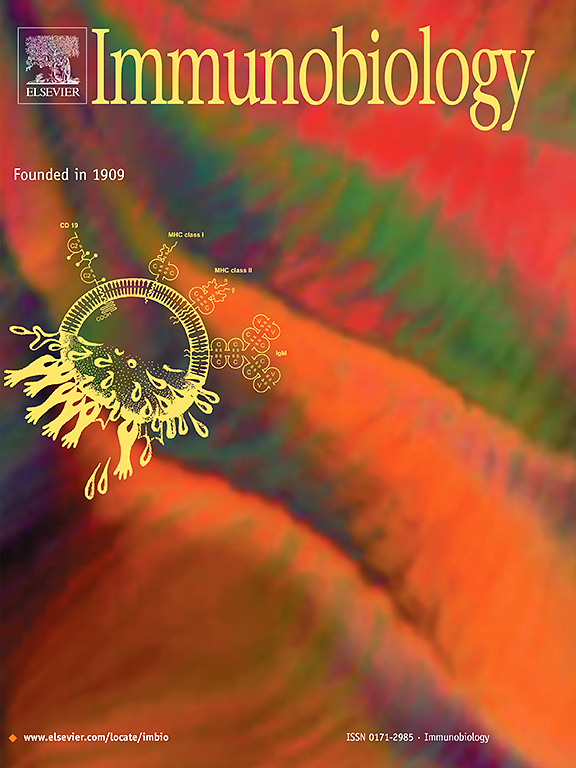Expression of human superoxide dismutase (SOD) 1 G93A and chlorovirus ATCV-1 SOD increases the response of macrophages to inflammatory stimulants, including ATCV-1 major capsid protein glycans
IF 2.3
4区 医学
Q3 IMMUNOLOGY
引用次数: 0
Abstract
One cause of familial Amyotrophic Lateral Sclerosis (ALS) is a mutation in Super Oxide Dismutase 1 (SOD1) whereby amino acid 93 is alanine instead of glycine (SOD1-G93A). Transgenic mice expressing human SOD1-G93A pathogenic variant develop motor neuron disease (MND), similar to ALS. Humans with ALS and SOD1-G93A mice have elevated production of inflammatory cytokines, such as IL-6, which may promote MND. We previously showed that infection with the Chlorovirus Acanthocystis turfacea chlorella virus 1 (ATCV-1), which encodes a SOD1, accelerates onset of MND in these mice and induces macrophages to produce high levels of IL-6. We confirm here that ALS patients compared with healthy controls have significantly elevated levels of plasma IL-6 and Interferon-gamma (IFN-γ), but not IL-17. To determine if expression of ATCV-1 SOD1 or SOD1-G93A in mouse macrophages elevates expression of inflammatory cytokines, we transfected the RAW264.7 mouse macrophage cell line with plasmids encoding ATCV-1 SOD1, wild-type human SOD1, SOD1-G93A, or an empty vector. RAW264.7 cells stably expressing wtSOD1 or G93A-SOD1 were stimulated with poly I:C and Interferon-gamma, alone, or in combination to induce inflammatory factors, such as IL-6 and Nitric Oxide (NO), anti-inflammatory factors, such as IL-10, or activation of Interferon Stimulated Response Elements (ISRE) promoters. After stimulation, production of IL-6 and NO, but not IL-10 or ISRE promoter activity was significantly higher in RAW264.7 cells expressing SOD1-G93A compared with wt SOD1. Moreover, RAW264.7 cells expressing SOD1-G93A compared with wt SOD1 produced higher levels of IL-6 and NO in response to ATCV-1 glycoproteins. Finally, transfection of plasmid encoding ATCV-1 SOD1 into RAW264.7 cells significantly increased expression of inflammatory factors in responses to poly I:C and IFN-γ, primarily in an Interferon regulatory factor 3 (IRF3) dependent fashion. These data clearly show that expression of G93A-SOD1 or ATCV-1 SOD1 in macrophages significantly elevates expression of inflammatory factors following stimulations that mimic virus infection, viral components, or T cell cytokines, thereby suggesting one mechanism by which atypical SOD1 in macrophages can contribute to ALS-MND.
人超氧化物歧化酶(SOD) 1 G93A和氯病毒ATCV-1 SOD的表达增加了巨噬细胞对炎症刺激物的反应,包括ATCV-1主要衣壳蛋白聚糖
家族性肌萎缩性侧索硬化症(ALS)的一个原因是超氧化物歧化酶1 (SOD1)突变,其中氨基酸93是丙氨酸而不是甘氨酸(SOD1- g93a)。表达人SOD1-G93A致病变异的转基因小鼠可发生类似ALS的运动神经元病(MND)。ALS患者和SOD1-G93A小鼠的炎性细胞因子如IL-6的产生升高,这可能会促进MND。我们之前的研究表明,感染了编码SOD1的绿病毒棘囊藻小球藻病毒1 (ATCV-1),加速了这些小鼠MND的发病,并诱导巨噬细胞产生高水平的IL-6。我们在此证实,与健康对照相比,ALS患者的血浆IL-6和干扰素γ (IFN-γ)水平显著升高,但IL-17水平无显著升高。为了确定ATCV-1 SOD1或SOD1- g93a在小鼠巨噬细胞中的表达是否会提高炎症因子的表达,我们用编码ATCV-1 SOD1、野生型人SOD1、SOD1- g93a或空载体的质粒转染了RAW264.7小鼠巨噬细胞细胞系。稳定表达wtSOD1或G93A-SOD1的RAW264.7细胞被poly I:C和干扰素- γ单独或联合刺激,诱导炎症因子,如IL-6和一氧化氮(NO),抗炎因子,如IL-10,或激活干扰素刺激反应元件(ISRE)启动子。刺激后,表达SOD1- g93a的RAW264.7细胞中IL-6和NO的产生明显高于表达SOD1- g93a的细胞,但IL-10和ISRE启动子活性不明显。此外,与SOD1表达的RAW264.7细胞相比,表达SOD1- g93a的细胞在ATCV-1糖蛋白的作用下产生更高水平的IL-6和NO。最后,将编码ATCV-1 SOD1的质粒转染RAW264.7细胞,显著增加炎症因子在poly I:C和IFN-γ反应中的表达,主要以干扰素调节因子3 (IRF3)依赖的方式表达。这些数据清楚地表明,巨噬细胞中G93A-SOD1或ATCV-1 SOD1的表达在模拟病毒感染、病毒成分或T细胞因子刺激后显著升高炎症因子的表达,从而提示巨噬细胞中非典型SOD1参与ALS-MND的一种机制。
本文章由计算机程序翻译,如有差异,请以英文原文为准。
求助全文
约1分钟内获得全文
求助全文
来源期刊

Immunobiology
医学-免疫学
CiteScore
5.00
自引率
3.60%
发文量
108
审稿时长
55 days
期刊介绍:
Immunobiology is a peer-reviewed journal that publishes highly innovative research approaches for a wide range of immunological subjects, including
• Innate Immunity,
• Adaptive Immunity,
• Complement Biology,
• Macrophage and Dendritic Cell Biology,
• Parasite Immunology,
• Tumour Immunology,
• Clinical Immunology,
• Immunogenetics,
• Immunotherapy and
• Immunopathology of infectious, allergic and autoimmune disease.
 求助内容:
求助内容: 应助结果提醒方式:
应助结果提醒方式:


